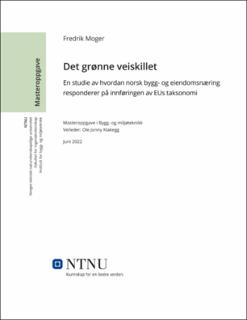| dc.contributor.advisor | Klakegg, Ole Jonny | |
| dc.contributor.author | Moger, Fredrik | |
| dc.date.accessioned | 2023-02-07T18:19:20Z | |
| dc.date.available | 2023-02-07T18:19:20Z | |
| dc.date.issued | 2022 | |
| dc.identifier | no.ntnu:inspera:116385539:25717108 | |
| dc.identifier.uri | https://hdl.handle.net/11250/3049056 | |
| dc.description.abstract | I august 2021 lanserte FNs klimapanel IPCC en rapport om klimaendringene. FNs generalsekretær kaller rapporten for «kode rød» for menneskeheten. Som den største forbrukeren av naturressurser legger bygg- og eiendomsnæringen et betydelig press på miljøet. En respons på denne utviklingen har vært «EU Green Deal» - EUs grønne giv. Sentralt i EUs grønne giv står EUs taksonomi, en klassifiseringsordning for å definere hva som er bærekraftige økonomiske aktiviteter. Taksonomien er fortsatt under utvikling, men bygg- og eiendomsnæringen er blitt en del av klassifiseringsordningen, og aktivitetene i næringen har med det en forutsetning for å bli klassifisert som bærekraftige.
Oppgaven ønsker å besvare tre forskningsspørsmål:
• Hvilken betydning har taksonomien for den norske bygg- og eiendomsnæringen?
• Hvordan responderer aktører i bygg- og eiendomsnæringen på innføringen av taksonomien?
• Ved implementering av taksonomien, hvilke utfordringer og løsninger står bygg- og eiendomsnæringen ovenfor?
For å besvare forskningsspørsmålene ble det gjennomført et litteraturstudie og 18 semistrukturerte intervjuer fordelt på fire grupper med aktører; eiendomsbesittere, bank- og finansinstitusjoner, juridiske aktører og tekniske aktører.
Resultatene viser at Norge sin manglende implementering av EU sine nyeste bygningsdirektiv har ført til uoverensstemmelser i flere sentrale begreper og definisjoner som gjør det utfordrende for aktører i norsk bygg- og eiendomsnæring å respondere på taksonomien. Videre viser resultatene at majoriteten av aktørene er fokusert på kriteriet som omhandler betydelig bidrag, og at kun fåtallet har kompetanse om «Do No Significant Harm»-kriteriene. Det mest sentrale funnet er at rimeligere finansiering ikke er hovedmotivasjonen til næringens respons, men at endringer i markedsbehov, er hoveddrivkraften. I tillegg viser resultatene mindre funn knyttet til at brune lån vil bære renterabatten til grønne lån, og at den potensielle effekten vil resultere i en 25 % rentespredning mellom grønne og brune bygg.
Konklusjonen er at endring i markedsbehov er den viktigste årsaken til å respondere, og at taksonomien kommer til å bli «gullstandarden» for bærekraftklassifisering av bygg. Videre konkluderer oppgaven med at det bør igangsettes initiativ fra næringslivet, myndigheter og akademia for å samle inn data som er relevant for taksonomien. | |
| dc.description.abstract | In August 2021, the UN’s Climate panel IPPC published a report regarding climate change. UN’s general deputy refers to the report as “code red” for humanity. Being the largest consumer of natural resources, the construction industry puts significant pressure on the environment. To respond to this development, the EU announced The Green Deal. At the center of the EU’s Green Deal, we find the EU taxonomy, a classification system to define sustainable economic activity. The taxonomy is still under development, but the construction industry has become a part of the taxonomy and the activities in the industry have thus the potential to be classified as sustainable.
This thesis seeks to answer three research questions:
• What is the impact of the EU taxonomy on the Norwegian construction industry?
• How does the actors in the industry respond to the implementation of the EU taxonomy?
• Which drivers and barriers are the Norwegian construction industry facing when aligning to the taxonomy?
To answer the research questions, the author conducted a literature review and 18 semi-structured interviews divided into four subgroups of industry players: real estate firms, financial institutions, legal actors, and technical actors.
The results show that Norway’s absent implementation of the latest EU building directive has led to inconsistencies in several definitions and concepts making it hard for the industry to respond to the taxonomy. Furthermore, the results illustrate that most of the actors are focusing on the substantial contribution criteria, while at the same time lacking knowledge regarding the do no significant harm criteria. The key finding of this thesis is that more favorable financing is not the main motivation to respond, rather that change in market needs is the main force. Additionally, the results show that brown loans will carry the interest rate rebate given to green loans and that the potential effect will result in a 25 % rent rate spread between green and brown loans.
The conclusion is that the market need for change is the key reason to respond and that the taxonomy will be the state-of-the-art method to classify sustainable economic activities in the construction industry. Moreover, the thesis concludes that the industry, government, and academia should start a data-gathering initiative to centralize data relevant to the taxonomy. | |
| dc.language | nob | |
| dc.publisher | NTNU | |
| dc.title | Det grønne veiskillet - En studie av hvordan norsk bygg- og eiendomsnæring responderer på innføringen av EUs taksonomi | |
| dc.type | Master thesis | |
